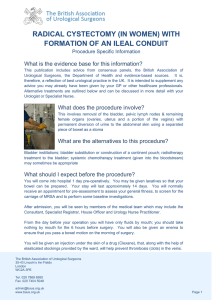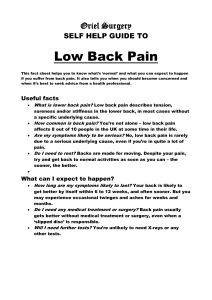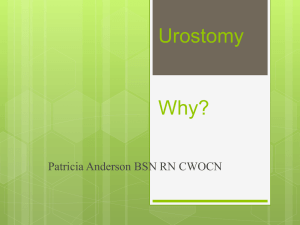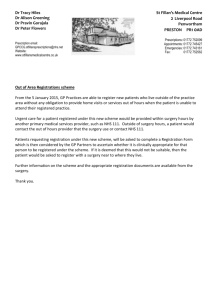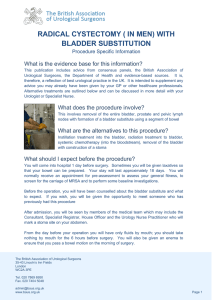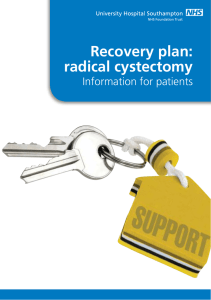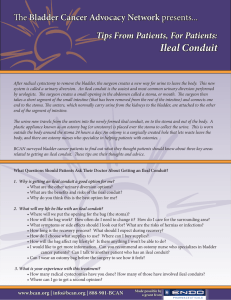RADICAL CYSTECTOMY (IN MEN) WITH FORMATION OF AN ILEAL CONDUIT
advertisement
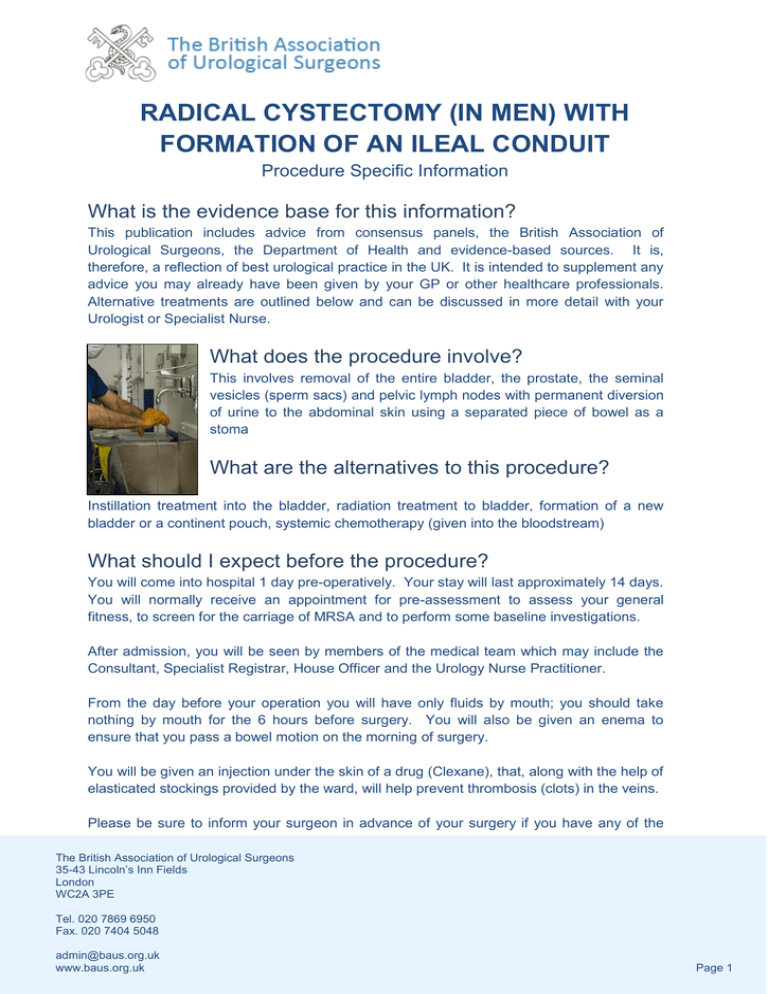
RADICAL CYSTECTOMY (IN MEN) WITH FORMATION OF AN ILEAL CONDUIT Procedure Specific Information What is the evidence base for this information? This publication includes advice from consensus panels, the British Association of Urological Surgeons, the Department of Health and evidence-based sources. It is, therefore, a reflection of best urological practice in the UK. It is intended to supplement any advice you may already have been given by your GP or other healthcare professionals. Alternative treatments are outlined below and can be discussed in more detail with your Urologist or Specialist Nurse. What does the procedure involve? This involves removal of the entire bladder, the prostate, the seminal vesicles (sperm sacs) and pelvic lymph nodes with permanent diversion of urine to the abdominal skin using a separated piece of bowel as a stoma What are the alternatives to this procedure? Instillation treatment into the bladder, radiation treatment to bladder, formation of a new bladder or a continent pouch, systemic chemotherapy (given into the bloodstream) What should I expect before the procedure? You will come into hospital 1 day pre-operatively. Your stay will last approximately 14 days. You will normally receive an appointment for pre-assessment to assess your general fitness, to screen for the carriage of MRSA and to perform some baseline investigations. After admission, you will be seen by members of the medical team which may include the Consultant, Specialist Registrar, House Officer and the Urology Nurse Practitioner. From the day before your operation you will have only fluids by mouth; you should take nothing by mouth for the 6 hours before surgery. You will also be given an enema to ensure that you pass a bowel motion on the morning of surgery. You will be given an injection under the skin of a drug (Clexane), that, along with the help of elasticated stockings provided by the ward, will help prevent thrombosis (clots) in the veins. Please be sure to inform your surgeon in advance of your surgery if you have any of the The British Association of Urological Surgeons 35-43 Lincoln’s Inn Fields London WC2A 3PE Tel. 020 7869 6950 Fax. 020 7404 5048 admin@baus.org.uk www.baus.org.uk Page 1 following: an artificial heart valve a coronary artery stent a heart pacemaker or defibrillator an artificial joint an artificial blood vessel graft a neurosurgical shunt any other implanted foreign body a regular prescription for Warfarin, Aspirin or Clopidogrel (Plavix®) a previous or current MRSA infection a high risk of variant-CJD (if you have received a corneal transplant, a neurosurgical dural transplant or previous injections of human-derived growth hormone) At some stage during the admission process, you will be asked to sign the second part of the consent form giving permission for your operation to take place, showing you understand what is to be done and confirming that you wish to proceed. Make sure that you are given the opportunity to discuss any concerns and to ask any questions you may still have before signing the form. Fact File 1 • The NHS Constitution Same-Sex Accommodation As a result of the new NHS constitution, the NHS is committed to providing samesex accommodation in hospitals by April 2010. This is because feedback from patients has shown that being in mixed-sex accommodation can compromise their privacy. The NHS pledges that: sleeping and washing areas for men and women will be provided the facilities will be easy to get to and not too far from patients’ beds To help accomplish this, the Department of Health has announced specific measures designed to “all but eliminate mixed-sex accommodation” by 2010. These include: more money for improvements in hospital accommodation providing help and information to hospital staff, patients and the public sending improvement teams to hospitals that need extra support introducing measures so that the Department can see how hospitals are progressing What happens during the procedure? A full general anaesthetic will be used and you will be asleep throughout the procedure. In some patients, the anaesthetist may also use an epidural anaesthetic to minimise postoperative pain. RADICAL CYSTECTOMY (IN MEN) WITH FORMATION OF AN ILEAL CONDUIT Page 2 In the operation, the bladder, the prostate, the seminal vesicles (sperm sacs) and, If necessary, the urethra (water pipe) are removed. Almost invariably, the nerves which control erections are damaged as they run very close to the prostate; sometimes it is possible to preserve these nerves and this will be discussed with you beforehand. The ureters (the tubes which drain urine from the kidneys to the bladder) are then sewn to a separated piece of small bowel which is positioned on the surface of the abdomen as an opening called a urostomy. The ends of the small bowel, from which the urostomy is separated, are then joined together again. You will be seen by a Urology Nurse Practitioner before your operation to mark the site where your stoma will be positioned and to try the various drainage bags available. If you wish, you will be given the opportunity to meet someone who has previously had this procedure. What happens immediately after the procedure? In general terms, you should expect to be told how the procedure went and you should: ask if what was planned to be done was achieved let the medical staff know if you are in any discomfort ask what you can and cannot do feel free to ask any questions or discuss any concerns with the ward staff and members of the surgical team ensure that you are clear about what has been done and what is the next move After your operation, you may be in the Intensive Care Unit or the Special Recovery area of the operating theatre before returning to the ward; visiting times in these areas are flexible and will depend on when you return from the operating theatre. You will have a drip in your arm and a further drip into a vein in your neck. You will be encouraged to mobilise as soon as possible after the operation because this encourages the bowel to begin working. We will start you on fluid drinks and food as soon as possible. You will usually have two tube drains in your abdomen and two fine tubes which go into the kidneys via the stoma to help with healing. Normally, we use injections and elastic stockings to minimise the risk of a blood clot (deep vein thrombosis) in your legs. A physiotherapist will come and show you some deep breathing and leg exercises, and you will sit out in a chair for a short time soon after your operation. It will, however, take at least 3-6 months, and possibly longer, for you to recover fully from this surgery. The average hospital stay is 14 days. RADICAL CYSTECTOMY (IN MEN) WITH FORMATION OF AN ILEAL CONDUIT Page 3 Are there any side-effects? Most procedures have a potential for side-effects. You should be reassured that, although all these complications are well-recognised, the majority of patients do not suffer any problems after a urological procedure. Common (greater than 1 in 10) Temporary insertion of a stomach tube through the nose, a drain and ureteric stents High risk of impotence (lack of erections) Inability to ejaculate or father children because the structures which produce seminal fluid have been removed (occurs in 100% of patients) Cancer may not be cured with removal of bladder alone MRSA wound infection (1 in 10 risk) Occasional (between 1 in 10 and 1 in 50) Anaesthetic or cardiovascular problems possibly requiring intensive care admission (including chest infection, pulmonary embolus, stroke, deep vein thrombosis, heart attack and death) Infection or hernia of the incision requiring further treatment Need to remove the penile urinary pipe (urethra) as part of the procedure Blood loss requiring repeat surgery Decreased kidney function with time Diarrhoea/vitamin deficiency due to shortened bowel requiring treatment Rare (less than 1 in 50) Bowel and urine leakage from anastomosis requiring re-operation Scarring to the bowel or ureters requiring operation in future Scarring, narrowing or hernia formation around stomal opening requiring revision Intra-operative rectal injury requiring colostomy Hospital-acquired infection Colonisation with MRSA (0.9% - 1 in 110) Clostridium difficile bowel infection (0.2% - 1 in 500) MRSA bloodstream infection (0.08% - 1 in 1250) The rates for hospital-acquired infection may be greater in high-risk patients e.g. with longterm drainage tubes, after removal of the bladder for cancer, after previous infections, after prolonged hospitalisation or after multiple admissions. What should I expect when I get home? By the time of your discharge from hospital, you should: RADICAL CYSTECTOMY (IN MEN) WITH FORMATION OF AN ILEAL CONDUIT Page 4 be given advice about your recovery at home ask when to resume normal activities such as work, exercise, driving, housework and sexual intimacy ask for a contact number if you have any concerns once you return home ask when your follow-up will be and who will do this (the hospital or your GP) ensure that you know when you will be told the results of any tests done on tissues or organs which have been removed When you leave hospital, you will be given a “draft” discharge summary of your admission. This holds important information about your inpatient stay and your operation. If you need to call your GP for any reason or to attend another hospital, please take this summary with you to allow the doctors to see details of your treatment. This is particularly important if you need to consult another doctor within a few days of your discharge. You will find that your energy levels are low when you get home and you will require assistance with many of the daily activities you normally take for granted. The wound clips will be removed in hospital or by the District Nurse. You will be contacted by the District Nurse to help you with the management of your stoma. You may experience problems with the stoma appliance in the early days, especially with leakage at night. As you become more familiar with your stoma and its fittings, this aspect will become less of a problem. The time taken to return to normal activity is between 2 and 4 months. What else should I look out for? There are a number of complications which may make you feel unwell and may require consultation with your GP or contact with the Urology Department. If you experience fever or vomiting, especially If associated with unexpected pain in the abdomen, you should contact your doctor immediately for advice. If you have any problems relating to the stoma or its attachments, you should contact the District Nurse or the Urology Department. Are there any other important points? It will be at least 14-21 days before the pathology results on the tissue removed are available. It is normal practice for the results of all biopsies to be discussed in detail at a multi-disciplinary meeting before any further treatment decisions are made. You and your GP will be informed of the results after this discussion. You will be brought back to the Hospital for a special scan to check that the kidneys are draining into the bowel correctly and you will be seen in the outpatient clinic after 6 weeks to check your progress and to discuss the results of your surgery. If the doctors decide that further treatment is required, the necessary appointments will be made for you at this stage RADICAL CYSTECTOMY (IN MEN) WITH FORMATION OF AN ILEAL CONDUIT Page 5 Driving after surgery It is your responsibility to ensure that you are fit to drive following your surgery. You do not normally need to notify the DVLA unless you have a medical condition that will last for longer than 3 months after your surgery and may affect your ability to drive. You should, however, check with your insurance company before returning to driving. Your doctors will be happy to provide you with advice on request. Is there any research being carried out in this area? Before your operation, your surgeon or Specialist Nurse will inform you about any relevant research studies taking place, and, in particular, if any surgically-removed tissue may be stored for future study. If this is the case, you will be asked if you wish to participate and, if you agree, to sign a special form to consent to this. All surgical procedures, even those not currently the subject of active research, are subjected to rigorous clinical audit so that we can analyse our results and compare them with those of other surgeons. In this way, we can learn how to improve our techniques and our results; this means that our patients will get the best treatment available. Who can I contact for more help or information? For further information on the internet, here are some useful sites to explore: Best Health (prepared by the British Medical Association) NHS Clinical Knowledge Summaries (formerly known as Prodigy) NHS Direct Patient UK Royal College of Anaesthetists (for information about anaesthetics) Royal College of Surgeons (patient information section) What should I do with this information? Thank you for taking the trouble to read this publication. If you wish to sign it and retain a copy for your own records, please do so below. If you would like a copy of this publication to be filed in your hospital records for future reference, please let your Urologist or Specialist Nurse know. However, if you do agree to proceed with the scheduled procedure, you will be asked to sign a separate consent form which will be filed in your hospital record. You will, if you wish, be provided with a copy of this consent form. I have read this publication and I accept the information it provides. Signature............................................................... Date........................................... RADICAL CYSTECTOMY (IN MEN) WITH FORMATION OF AN ILEAL CONDUIT Page 6 How can I get information in alternative formats? Please ask your local NHS Trust or PALS network if you require this information in other languages, large print, Braille or audio format. Most hospitals are smoke-free. Smoking increases the severity of some urological conditions and increases the risk of post-operative complications. For advice on quitting, contact your GP or the NHS Smoking Helpline free on 0800 169 0 169 Disclaimer While every effort has been made to ensure the accuracy of the information contained in this publication, no guarantee can be given that all errors and omissions have been excluded. No responsibility for loss occasioned by any person acting or refraining from action as a result of the material in this publication can be accepted by the British Association of Urological Surgeons Limited. Fact File 2 • The NHS Constitution Patients’ Rights & Responsibilities The constitution, as a result of extensive discussions with staff and the public, sets out new rights for patients which will help improve their experience within the NHS. These new rights include: a right to choice and a right to information that will help them make that choice a right to drugs and treatments approved by NICE when it is considered clinically appropriate a right to certain services such as an NHS dentist and access to recommended vaccinations the right that any official complaint will be properly and efficiently investigated, and that they be told the outcome of the investigations the right to compensation and an apology if they have been harmed by poor treatment The constitution also lists patient responsibilities, including: providing accurate information about their health taking positive action to keep themselves and their family healthy trying to keep appointments treating NHS staff and other patients with respect following the course of treatment that they are given giving feedback, both positive and negative, after treatment RADICAL CYSTECTOMY (IN MEN) WITH FORMATION OF AN ILEAL CONDUIT Page 7
